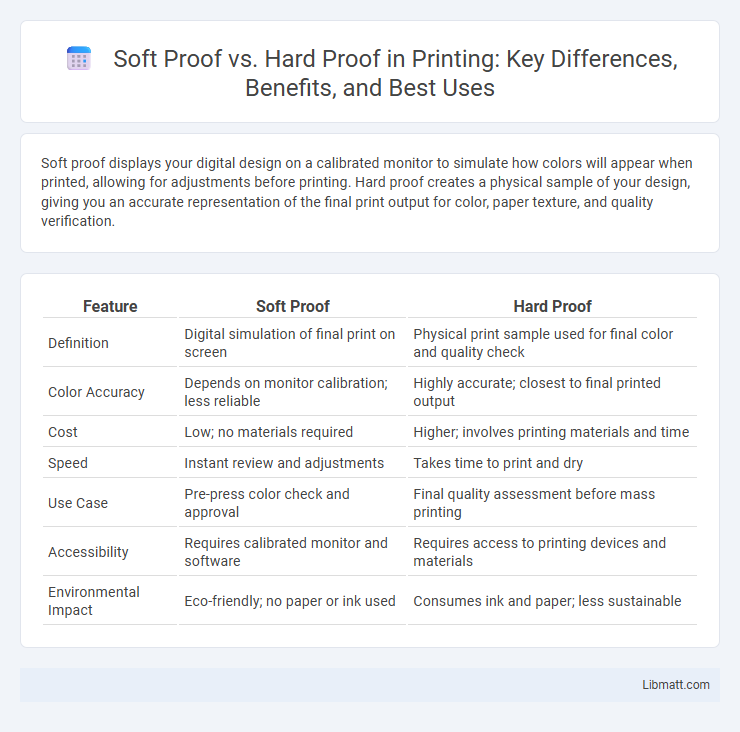Soft proof displays your digital design on a calibrated monitor to simulate how colors will appear when printed, allowing for adjustments before printing. Hard proof creates a physical sample of your design, giving you an accurate representation of the final print output for color, paper texture, and quality verification.
Table of Comparison
| Feature | Soft Proof | Hard Proof |
|---|---|---|
| Definition | Digital simulation of final print on screen | Physical print sample used for final color and quality check |
| Color Accuracy | Depends on monitor calibration; less reliable | Highly accurate; closest to final printed output |
| Cost | Low; no materials required | Higher; involves printing materials and time |
| Speed | Instant review and adjustments | Takes time to print and dry |
| Use Case | Pre-press color check and approval | Final quality assessment before mass printing |
| Accessibility | Requires calibrated monitor and software | Requires access to printing devices and materials |
| Environmental Impact | Eco-friendly; no paper or ink used | Consumes ink and paper; less sustainable |
Introduction to Proofing in Printing
Proofing in printing ensures color accuracy and print quality before final production. Soft proofing uses digital screens to simulate print output, allowing quick adjustments without physical samples. Hard proofing produces physical print samples, offering precise color and material representation essential for contract approval.
What is Soft Proof?
Soft proof is a digital simulation of how your printed materials will appear, allowing you to preview color accuracy and image quality on your screen before printing. This method uses calibrated monitors and specialized software to replicate ink colors and paper textures, helping to identify potential issues without wasting physical resources. Soft proofing streamlines the design process by providing a cost-effective way to ensure your final print matches your expectations.
What is Hard Proof?
Hard proof is a physical print produced from digital files to evaluate color accuracy, detail, and overall print quality before mass production. It serves as a tangible reference for comparing how colors and images will appear on the final product, helping to identify issues like color shifts or resolution problems. You rely on hard proofs to ensure precise color matching and quality control in printing workflows.
Key Differences Between Soft Proof and Hard Proof
Soft proof uses digital displays to simulate printed colors, enabling quick and cost-effective color adjustments before production. Hard proof involves physically printed samples on actual substrates, providing accurate color and material representation essential for final quality assurance. Key differences include medium fidelity, cost, turnaround time, and reliability in color matching for different stages of the print workflow.
Advantages of Soft Proofing
Soft proofing offers the advantage of real-time, on-screen color accuracy, enabling designers to preview how digital images will appear when printed without the need for physical printouts. This method significantly reduces costs and environmental impact by minimizing the use of ink, paper, and other printing materials during the proofing stage. Advanced color management systems integrated into soft proofing software ensure consistent color profiles across devices, enhancing workflow efficiency and reducing the risk of costly color mismatches in final prints.
Advantages of Hard Proofing
Hard proofing offers tangible color accuracy by providing a physical printout that closely represents the final product, allowing you to detect color shifts and print defects before mass production. This method eliminates the uncertainty of digital displays, ensuring precise evaluation under standardized lighting conditions. Hard proofing ultimately reduces costly errors and enhances quality control in the printing process.
Limitations of Soft Proofing
Soft proofing relies on monitor calibration and software accuracy, which can vary widely between devices, leading to inconsistent color representation. It cannot fully replicate the physical texture, gloss, and substrate-specific effects observable in a hard proof. Limitations in ambient lighting conditions and device capabilities further reduce the reliability of soft proofs for final color-critical decisions in print production.
Limitations of Hard Proofing
Hard proofing is limited by its reliance on physical materials and inks, which can result in color inconsistencies due to variations in printer calibration and substrate properties. It lacks the flexibility to quickly adjust colors or simulate different printing conditions without generating new proofs, leading to increased costs and time delays. Unlike soft proofing, hard proofing cannot easily replicate complex color profiles or spot color matching, making it less efficient for precise color-critical workflows.
Choosing the Right Proofing Method
Choosing the right proofing method depends on your project's needs for color accuracy and turnaround time. Soft proofing uses digital displays to simulate print colors, ideal for quick revisions and cost-saving, while hard proofing produces physical samples that provide precise color matching critical for final approvals. Your decision should balance the benefits of immediate soft proof adjustments against the tangible accuracy of hard proofs to ensure print quality meets expectations.
Conclusion: Soft Proof vs Hard Proof
Soft proof offers a digital simulation of print output, allowing you to preview colors and make adjustments before printing, saving time and reducing waste. Hard proof provides a physical, tangible sample that guarantees color accuracy and print fidelity, essential for final approvals in high-quality projects. Choosing between soft and hard proof depends on your need for convenience versus precise color matching in the production process.
Soft Proof vs Hard Proof Infographic

 libmatt.com
libmatt.com